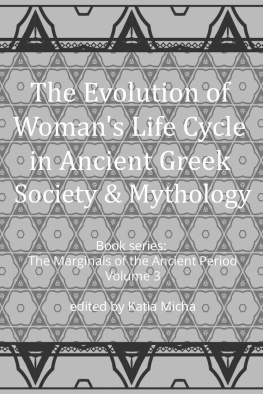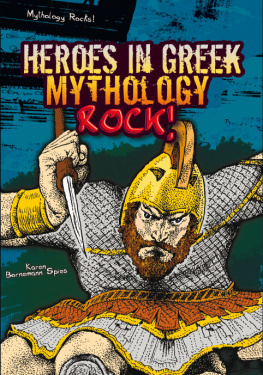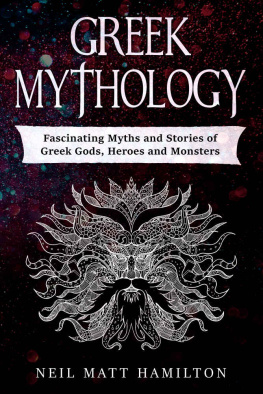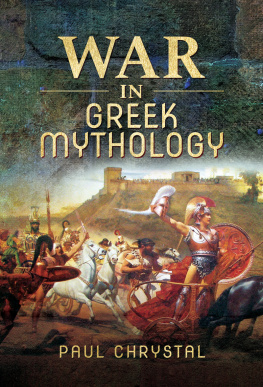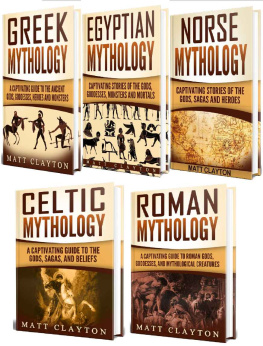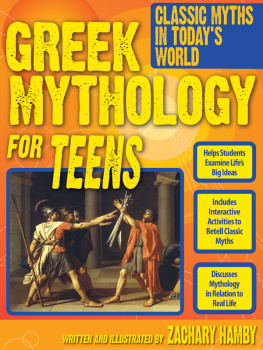All rights and licenses reserved.
Independently published, July 2020
Book series: The Marginals of the Ancient Period
Volume 3: The Evolution of Woman's Life Cycle in Ancient Greek Society and Mythology
Edited by Aikaterini (Katia) Micha
Athens, Greece
Table of Contents
A WOMAN IN ATHENS IN the fifth century moved through certain stages in her life, from menarche to marriage to motherhood. Each stage was signified biologically by a loss of blood from the woman and, often more importantly, by social rituals which serve to highlight the transition into a new stage. The goddess Artemis is present and active at each of these stages of a womans development.
The main topic of investigation in this book is the position and place of women, both real and mythical, as they progress through these stages. It might seem that the role of women was entirely prescribed by men. In fact, women who grow and move from menarche to motherhood are active, at some level, in the debate about their position and role in society, in part, this debate took place through myths and rituals. In what follows, we attempt to reveal some aspects of the way these two provinces, women both in everyday life and in myth and ritual, overlap, relate, and interpenetrate. The point of intersection is achieved in the presentation of the goddess Artemis. Her actions as a goddess of transitions links both the bleeding women of the gynaecological texts and the extraordinary women of the myths.
This area of investigation is approached with the application of social anthropological theory to the evidence. The model, which will be discussed in Chapter 1, concerns the rites of passage identified by Arnold van Gennep and expanded by Victor Turner. Turner stresses the concept of liminality within these rites of passage, specifically the period in a females life after the menarche and before marriage. It is during this period that the female is liminal; she is betwixt and between the categories of child on the one hand and wife and mother on the other. During this time she exists in an ambiguous state because she is physically capable of bearing a child but is socially unable to do so prior to marriage. Turner further differentiates between two models of human relations: status and liminality. In status society, value Is arranged according to an hierarchy. Turner describes classical Athens as a status-structured society. The liminal occasions within a status structure are those moments when hierarchy fails to dictate precise expectations for behaviour. It is a paradox that status society should include liminality as regularised periods within the status structured society. It will be shown that liminality is crucial to its structure, and this contradiction is epitomised in the body of the parthenos.
Anthony Giddens structuration theory concentrates on social practices as the basis of social structure. Through social interaction agents maintain the social structure as well as contribute to its evolution. Significantly, social agents include all competent individuals, both men and women. On some level, these agents are aware or knowledgeable about the routines of social life which their collective actions form. This theory reveals classical Athens as a society continually reproduced through the actions of its agents and not as a pre-given static entity. Thus, human action constructs the production, reproduction and change in society.
The ability to account for change and action in society is crucial when considering the conceptual ambiguity presented by the evidence for women. To combat this ambiguity, Pierre Bourdieus concept of the habitus is useful. The term habitus refers to the cumulative social expectations which inform agents decisions and actions. These expectations are distinct from those adopted through a conscious effort. The habitus represents the conceptual agency through which social perceptions are acquired.
These social anthropological thinking tools will be combined to form a model. This complex model, when applied to the range of evidence considered, renders the position and role of women in classical Athens more accessible to study. A clearer picture of womens role emerges by defining as reciprocal the relationship between expectation and action. The model demonstrates the way expectation creates and reinforces action, which in turn informs expectation. In this way the production and reproduction of society is explained.
In Chapter 2, the movement of women through the stages of their lives is traced through the discussions in the ten gynaecological texts of the Hippocratics and in the gynaecological information contained in Aristotles biological texts. From these texts it is clear that the health of a woman is assessed through successful passage of certain stages of bleeding. Such stages are the necessary prerequisite in order to approach the most medically and socially desirable destination for women: marriage and motherhood. These biological occurrences of bleeding correspond to the womans movement through different categories of social status. The medical ideal of the healthy woman who bleeds regularly has a social motivation. It will be shown that the medical conception of the normal woman meets the social conception of the normal woman in the physical body of the real woman. The evidence taken from these medical treatises will serve as a control against which to compare the evidence of womens roles and transitions presented in myths, van Gennep identified the progressive stages in a womans life and labelled the movement through these stages the rites of passage. The term total passage will be used to signify the overall transition which includes the various intermediary stages that a woman progresses through from childhood to widowhood. The term rite of passage will be used to indicate an individual complete particular movement from one status to another through a religious ritual. For example, in and of itself the arkteia, composed of individual elements, is a complete rite of passage. Turner uses the identification of the various rites of passage as a foundation for his concept of liminality. He identified that within the total passage which includes these stages there are distinct periods of ambiguity which inform the paradox of the position of women in status society. To combat the liminality encompassed in the body of the woman, rituals are constructed by society.
Next page
